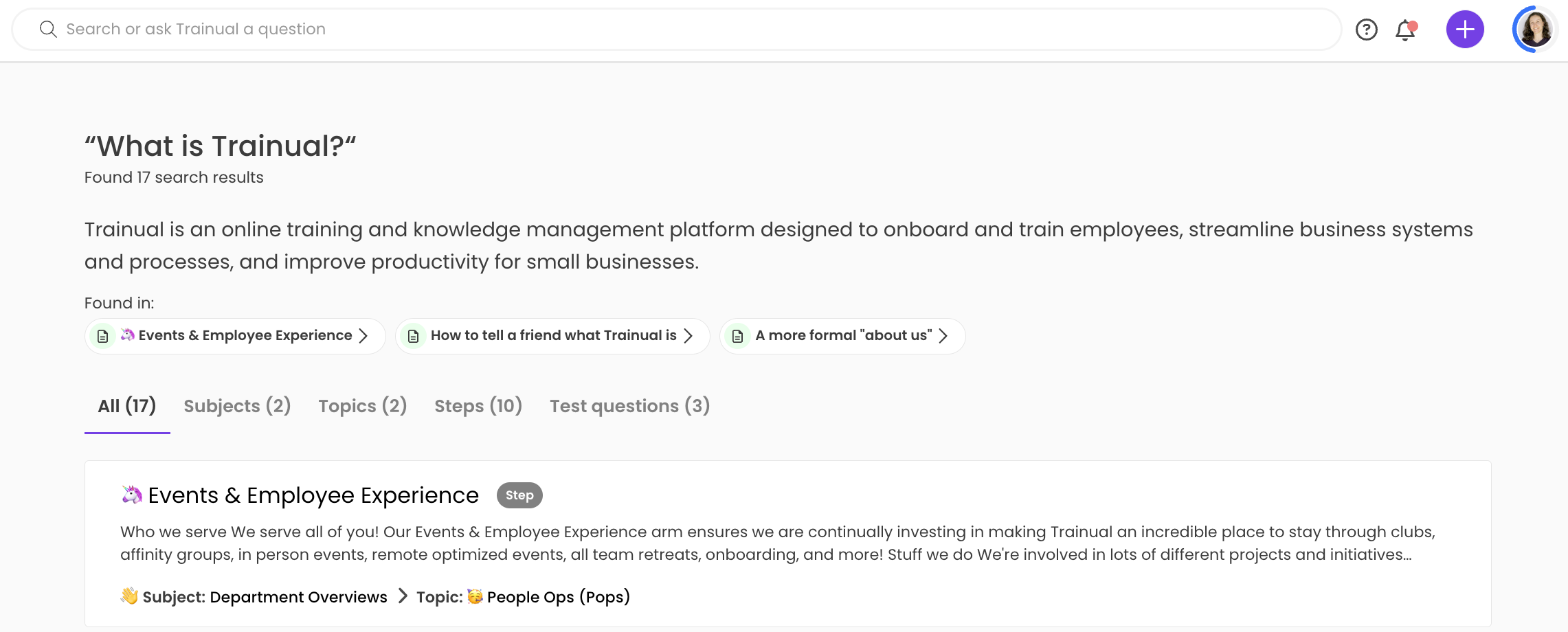Every customer experience process you need in your business (with templates!)
November 8, 2023
You know daylight savings is over when everyone around the water cooler just talks about how dark it is when they leave the office. Happy end of daylight savings to all (forced) to celebrate!
Hot off the SMB press this week:
- A comprehensive set of templates to train employees on customer success.
- The importance of treating all customers with respect and urgency — no matter what.
- Using Trainual as the answer to all your FAQs.
- How to use predictive analytics to improve your marketing and customer service efforts.
STARTER PACK
Templates of the week: Customer Experience Starter Pack

Building an award-winning customer experience team takes more than just hiring great people. Because you could have the most trustworthy, on-top-of-it employee chatting with your customer and the outcome could totally flop. And the problem could actually be the processes (or lack thereof) you share with your customer-facing team.
When you cruise through your favorite drive-thru and order your go-to meal, you expect it to taste exactly the same as last time. Otherwise, you’ll be disappointed. Just like you, your customers need (and expect) consistency with your services — and that includes your customer support.
👉 Make sure the all-stars on your customer experience team are on the same page with our Customer Experience Template Starter Pack. It covers the repeatable processes and policies your team needs to provide consistent experiences. Every. Day.
Here’s what the starter pack includes:
- New Customer Onboarding Process Template.
- Measuring Customer Satisfaction Process Template.
- Handling Customer Support Tickets Process Template.
- Fielding Inquiries from Customers and Prospects Process Template.
- Managing Customer Self-service Support Process Template.
- Resolving Customer Complaints Process Template.
- Customer Escalations Process Template.
- Post-Sale Handoff to Customer Success Process Template.
- Customer Service Manager (CSM) Role and Responsibilities.
- Customer Exchange, Return, and Refund Policy Template.
- Managing the Customer Loyalty Program Process Template.
- Collecting Customer Testimonials Process Template.
- Asking for Customer Referrals Process Template.
- Customer Contract Renewal Process Template.
- Customer Review Response (G2) Process Template.
- Customer Review Response (Capterra and Software Advice) Process Template.
- Customer Success Upsell and Downgrade Process Template.
🔥 Tip: If you’re new to Trainual, you can add all 16 process templates to your free trial account in one click! Create a new account with the Customer Experience Template Starter Pack.
Want more templates to help you build your business playbook? Check out our entire template archive of free, multimedia-enhanced, and customizable policy, process, and role starters. New to Trainual? Get a demo.
TREAT YOU BETTER
Why you need a repeatable process for how to treat customers
SMB leaders know that there are three words that can make or break a business: word of mouth. Testimonials and referrals speak volumes about your company — meaning you have to make sure each customer gets that A+ customer service experience you know your team can dish.
Why? Over two-thirds of consumers are willing to pay more for products and services if the business is known for good customer service (and 93% are likely to make repeat purchases).
Here are three philosophies to integrate into your customer experience processes — even when the customer is (not) always right.
Show everyone respect.
You already know this. People remember when they’re treated poorly by businesses, and they’ll have a scathing Yelp review ready to go. Plus, 61% of customers are ready to dump you on your behind after a single bad experience. So be sure to stack your team with a customer escalation process so you know they’re resolving those one-off issues in the best way.
Build trust through integrity.
Be comfortable admitting when things aren’t working out with a client’s project. When you keep them informed on the good and the bad, they’ll be more likely to appreciate your transparency and partnership, which can ultimately lead to a better relationship.
Act urgently.

Customers are used to getting what they want now — making them seriously impatient. (Thanks, Amazon Prime.) That means you have to act quickly to impress them. And remember: They’re seeking a minimal wait and optimal results — so ensure their experience is satisfactory enough to where they’ll come back and refer a friend.
🔥 Tip: Snag 16 repeatable processes and policies for your customer service team above!
TRAINUAL TIPS
Help employees get immediate answers to FAQs
No matter what type of business you run, there will always be questions. Questions from partners and vendors, employees, customers — someone always has a question about something in your business. And some questions get asked more than others.
Think about your typical work week. What are the top ten most common questions you get asked? And if you had a nickel for every time you heard those questions, how much money would you have?
Now, having to answer the same questions over and over isn’t just a drag. It’s a drain on your valuable time — time that could be better spent on your actual responsibilities. So, why waste any more of it, especially when the solution is a click away?

With Trainual, you can document the answers to all the frequently asked questions — everything you get pinged on by your team and anything your employees get asked by customers — so it all exists in one easy-to-access place. Plus, with Trainual’s AI-powered capabilities, anyone can put a question into the search and the platform will surface the answer directly (as long as it exists in your Content page).
👉 Start building your FAQs in your account. (New to Trainual? Get a demo.)
SEE THE FUTURE
Predictive analytics: Improving marketing and customer success
Running a successful business means knowing your audience.
It feels like a cardinal rule for small businesses: Find out what your customers need and provide a solution. But when it comes to growing your business through marketing, customer satisfaction, and other factors, sometimes just knowing what your customers need now isn’t enough. And that’s where predictive analytics comes into play.
What is it?
Think of the variety of customer data you collect. Predictive analytics finds hidden patterns in that data to forecast future outcomes. When you can “see the future,” you can better personalize your marketing strategies, target high-value customers, and optimize your spending.

Makes sense. So, how does it work?
Glad you asked — here are a few ways you can use predictive analytics to improve your marketing and customer experience efforts:
- Better customer segmentation. Your data will reveal your high-value customers based on factors like demographics, purchasing habits, and preferences. You may find that your products and services are more popular in one county over another, or younger spenders are making more purchases during the summer months. You can make more personalized marketing for these groups — generating even more value.
- Optimized spending. One benefit of predictive analytics is forecasting a customer’s estimated lifetime value. The data will reveal which customers will likely stay with your business and which won’t. With that information in hand, you can be smart about where you’re spending your marketing budget — ensuring that you’re focused on retaining the customers who are more likely to stay than those who aren’t.
- Measured effectiveness. Predictive analytics isn’t just about predicting the future — it’s about seeing if your forecasts aligned with actual outcomes and adjusting accordingly. Let’s say you started a loyalty program for a specific customer segment that was predicted to generate more revenue — but instead, customers are leaving. Analyzing what’s happening there can help you pinpoint problems in your business, and fixing those issues will only improve your customer experience.




